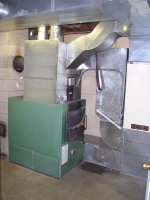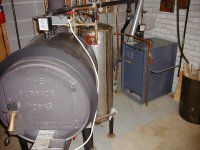I used to own a wood electric furnace in my first home. Like you, I ran out of dry timber before the season was half over.. anyways, started mixing green with dry, and then eventually mostly green. The result was a river of creosote flowing out of the chimney clean out, two chimney fires, and an etched basement floor from the acids in the creosote. My experience was that a forced air furnace pulls too much heat out of the flew gasses, and that it was almost impossible to monitor the furnace closely enough to prevent the creation of creosote.
I will never forget the evening I came from work, started the fire in the box, walked away for ten minutes, and came back to an out of control chimney fire. The pipe exiting the furnace was white.. almost see through.
The furnace was sold that summer. Wood was far too expensive anyways.
The key to heating with wood is proper installation, operation and maintenance.
My installation seems different from the one you had. I've attached a photo. The electric furnace is the white box on the right side and its blower only circulates air in the plenum that surrounds the wood furnace. Except for the chimney and thermostat-controlled air inlet below the furnace door the firebox is sealed. The blower does not move any air from around the chimney.
A thermostat opens the furnace air intake if the room temperature calls for it. If the fire gets too hot the other thermostat closes the air intake until it cools. The blower only operates if the furnace is fairly warm. Otherwise heat circulates by convection. We set the electric furnace at 64 F and it will take over if there is no wood fire.
The cleanout in the bottom left of the photo is no longer operative. The stainless steel liner (which was installed to meet insurance requirements) runs directly to the furnace chimney outlet. Although it looks bad, the blackened area about the furnace door is not dangerous. It is from over 25 years of small amounts of smoke that sometimes escapes as you start or reload the fire.
Because it is also setup for air conditioning the system is a bit more complex than for just wood. The "winter" setting directs air from the furnace blower along the bottom duct to the bottom of the wood furnace. The "summer" setting directs it up through the air conditioner exchanger to the left of the electric furnace and top of the plenum above the furnace.
I think a key to operating safely is to use only dry wood (my dries for at least 18 months in a covered area). Also, we make a point of burning at least one hot fire each morning and never have the dangerous shiny-black creosote. I have the furnace and chimney cleaned by a certified installer once per year. I could do it myself but find in worth the $120 for the peace of mind.
Wood is free where I live except for the work (which I enjoy) and fuel for cutting. There is more than enough naturally recycling wood on my acreage but unlimited amounts in the surrounding area. Wood gathering is allowed on crown land (which is the vast majority) simply by downloading and signing a form with the rules and having it with you while cutting. The rules are reasonable--no cutting live trees or "wildlife apartment" trees and within maximum lengths and diameters meant to prevent lumber and log harvesting. I've attached a copy of the permit.
Another advantage of the wood furnace is that it continually puts out heat rather than the hot-cool cycles of a typical gas, oil or electric hot air furnace.
Although the wood is free and heat is more comfortable it would not make sense to do this if I didn't enjoy the work. But I would end up burning much of the wood in open piles anyhow just to maintain access to the property.
The main advantage is it provides another excuse to play with the tractor.

